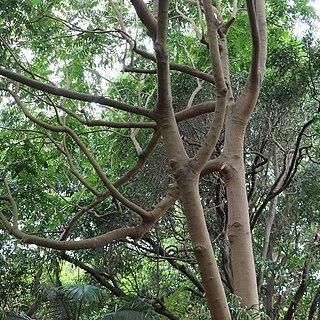Tree to 34 m (–58 m teste Koorders & Valeton, l.c.) with clear bole to 25 m and 150 cm diam., fluted, buttresses to 2 m (–5 m, Koorders, 1913) tall, 1 m out, concave. Bark grey-brown with elongated brown lenticels, becoming pustular and cracking vertically or scaling; inner bark yellow-brown, flecked orange; sapwood pale brown, often with strong smell of garlic, onions, potatoes or turnips; heartwood hard, deep red. Crown rather irregular with terminal rosettes of leaves. Twigs ascending, cicatrose, brown or reddish, often conspicuously lenticellate; leafy twigs to c. 1 cm diam., ± lenticellate, glaucous to reddish, subglabrous to densely yellow pubescent. Apical buds with fistshaped young leaves. Leaves 25–95 cm, imparipinnate, up to 14(–17)-jugate, the distal leaflets developing ± some time after the more proximal; petiole 5–10 cm, 3–4 mm diam., subglabrous to softly pubescent, often lenticellate, somewhat flattened adaxially or ± terete, base weakly swollen to clasping; rachis c. 3 mm diam., glabrescent to ± pubescent. Leaflets opposite to subopposite, c. 13–16 by 4–5 cm, the most proximal smaller, c. 6.5 by 3.5 cm, the apical often and the most distal laterals sometimes falling before developing, oblong to ovate, glabrous to sparsely pubescent, especially on veins adaxially, subglabrous to densely soft pubescent abaxially, rarely with domatia, base symmetric to asymmetric, obtuse to subcordate distally, acute to cuneate proximally, apex apiculate to acute; costae c. 10–12 on each side, prominent abaxially, obtuse, mostly ± bifid 2/3 from midrib and anastomosing; petiolules 2–7 mm. Thyrses to 60 cm, axillary to supra-axillary, pendent, 1-or 2-branched, the primary to 12 cm, the more distal shorter, the secondary to c. 1 cm bearing sweetly scented multiflowered fascicles; bracts and bracteoles 2 or 3, c. 1 mm long, triangular, ± densely pubescent; pedicels 0–1 mm. Calyx c. 1 mm long, 1.5 mm diam., salveriform to shallowly cupular, ± densely adpressed pubescent, 4-lobed, the lobes irregularly triangular. Petals 4 (or 5), 8–12 mm long, linear, cream, ± sparsely pubescent without, ± imbricate at apices, adnate to staminal tube in proximal half. Staminal tube hairy on both sides, especially villous within, weakly ribbed, the margin subtruncate to 8-lobed, the lobes ± emarginate; anthers 8, c. 0.5 mm long, oblong, weakly locellate, glabrous, included. Disk 2–4 mm long, cylindrical, glabrous to pubescent, green, margin irregularly 4-toothed. Ovary ± sericeous 4-locular, each locule 1-ovulate; style terete, sericeous to villous in proximal half; stylehead subdiscoid to short-cylindrical. Capsule 15–25 mm diam., flattened globose, glabrous, 4-valved, red-brown, smooth or pustular-lenticellate; pericarp with white latex. Seeds 1–4, to 16 mm long, plano-convex, with red aril; cotyledons collateral, with white latex.
More
Trees 7-10(-20) m tall. Branchlets puberulent; apical buds with leaves like clenched fists. Leaves alternate, 25-30(-45) cm, odd-pinnate; petiole and rachis glabrous or villous; leaflets 20-23, opposite to subopposite; petiolules 3-5 mm, glabrous or pubescent; leaflet blades oblong to oblong-lanceolate, 5-11(-13) × 2-3.5(-4.5) cm, membranous, abaxially glabrous or sparsely villous but densely villous on midvein and secondary veins, adaxially glabrous or densely pubescent only on midvein, secondary veins 12-15 on each side of midvein and outspreading, base oblique, apex acuminate. Thyrses axillary, ca. 18 cm or more, lax and with a few scattered flowers, nearly glabrous to sparsely pubescent; branches few, sparse, ca. 5 cm at base of thyrse. Flowers 4-merous, ca. 9 mm. Pedicel 1-2 mm, pubescent. Calyx disciform, ca. 2 mm in diam., pubescent, lobes round. Petals yellow, linear to spatulate, ca. 8.5 mm, glabrous, apex obtuse. Staminal tube cylindric, ca. 7 mm, both surfaces white villous, apical margin crenate; anthers 8. Disk cylindric, ca. 3 mm high, margin ciliate and crenate. Ovary densely villous; style 7-8 mm. Capsule yellow when dry, globose, 1.6-2 cm in diam.; pericarp thin and flexible. Fl. May-Sep and Jan-Feb, fr. Oct-Nov and Mar-Apr.


